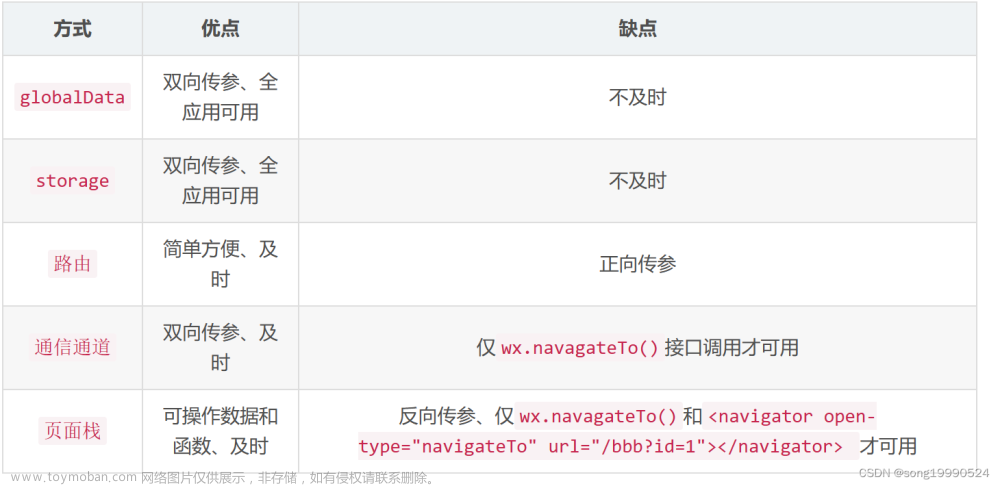在uniapp中,页面传参是非常常见的需求。本文将详细讲解uniapp中页面传参的传递方式和接受方式,以及使用案例,同时附上代码注释。
一、传递方式
1. URL传参
URL传参是一种比较简单的传递方式,它是通过URL地址来传递参数的。我们可以在URL地址后面加上参数,例如:
<uni-button @click="goToDetail">跳转到详情页</uni-button>//编程式传参 比较常用
<navigator url="/pages/detail/detail?id=123">跳转到详情页</navigator>//标签传参
// 跳转到详情页,并传递id参数
goToDetail() {
uni.navigateTo({
url: '/pages/detail/detail?id=123'
})
}
在接收页面中,我们可以通过this.$route.query来获取传递的参数:
export default {
onLoad() {
console.log(this.$route.query.id) // 输出:123
}
}
对于微信小程序 this.$ route.query.id 可能不能使用 因为微信小程序不识别 this.$ route
而替代方案
不使用this.$ route 使用 onload传参
onLoad(getData) {//getData就是参数对象 兼用微信小程序
console.log(getData.id);
}
2. Storage传参
Storage传参是通过uni-app提供的Storage API来传递参数的。我们可以在跳转之前将参数存储到Storage中,然后在接收页面中获取:
<uni-button @click="goToDetail">跳转到详情页</uni-button>
// 跳转到详情页,并将id参数存储到Storage中
goToDetail() {
uni.setStorageSync('id', 123)
uni.navigateTo({
url: '/pages/detail/detail'
})
}
在接收页面中,我们可以通过uni.getStorageSync来获取存储的参数:
export default {
onLoad() {
console.log(uni.getStorageSync('id')) // 输出:123
}
}
3. Vuex传参
Vuex传参是通过uni-app提供的Vuex API来传递参数的。我们可以在跳转之前将参数存储到Vuex中,然后在接收页面中获取:
<uni-button @click="goToDetail">跳转到详情页</uni-button>
// 跳转到详情页,并将id参数存储到Vuex中
goToDetail() {
uni.$emit('setId', 123)
uni.navigateTo({
url: '/pages/detail/detail'
})
}
在Vuex中,我们可以定义一个state来存储参数:
const store = new Vuex.Store({
state: {
id: ''
},
mutations: {
setId(state, id) {
state.id = id
}
}
})
在接收页面中,我们可以通过mapState来获取存储的参数:
import { mapState } from 'vuex'
export default {
computed: {
...mapState(['id'])
},
onLoad() {
console.log(this.id) // 输出:123
}
}
4.api传参eventChannel
api传参是通过uni-app提供的API来传递参数的。我们可以在跳转之前将参数存储到options中,例如:
<uni-button @click="goToDetail">跳转到详情页</uni-button>
// 跳转到详情页,并传递id参数
goToDetail() {
uni.navigateTo({
url: '/pages/detail/detail',
success: (res) => {
res.eventChannel.emit('acceptDataFromOpenerPage', { id: 123 })
}
})
}
在这个例子中,我们使用了eventChannel来传递参数。我们在跳转之前,通过success回调函数来获取eventChannel,然后通过emit方法来传递参数。
在api传参的方式中,我们可以通过uni.on来监听传递的参数:
export default {
onLoad() {
const eventChannel = this.getOpenerEventChannel()
eventChannel.on('acceptDataFromOpenerPage', (data) => {
console.log(data.id) // 输出:123
})
}
}
在这个例子中,我们通过getOpenerEventChannel方法来获取eventChannel,然后通过on方法来监听传递的参数。
二、接受方式
1. URL传参
在URL传参的方式中,我们可以通过this.$route.query来获取传递的参数:
export default {
onLoad() {
console.log(this.$route.query.id) // 输出:123
}
}
2. Storage传参
在Storage传参的方式中,我们可以通过uni.getStorageSync来获取存储的参数:
export default {
onLoad() {
console.log(uni.getStorageSync('id')) // 输出:123
}
}
3. Vuex传参
在Vuex传参的方式中,我们可以通过mapState来获取存储的参数:
import { mapState } from 'vuex'
export default {
computed: {
...mapState(['id'])
},
onLoad() {
console.log(this.id) // 输出:123
}
}
4.api传参eventChannel
在api传参的方式中,我们可以通过uni.on来监听传递的参数:
export default {
onLoad() {
const eventChannel = this.getOpenerEventChannel()
eventChannel.on('acceptDataFromOpenerPage', (data) => {
console.log(data.id) // 输出:123
})
}
}
在这个例子中,我们通过getOpenerEventChannel方法来获取eventChannel,然后通过on方法来监听传递的参数。
三、使用案例
下面是一个完整的使用案例,包括传递和接收参数的方式:
// pages/index/index.vue
<template>
<view>
<uni-button @click="goToDetail">跳转到详情页</uni-button>
</view>
</template>
<script>
export default {
methods: {
goToDetail() {
// URL传参
// uni.navigateTo({
// url: '/pages/detail/detail?id=123'
// })
// Storage传参
// uni.setStorageSync('id', 123)
// uni.navigateTo({
// url: '/pages/detail/detail'
// })
// Vuex传参
uni.$emit('setId', 123)
uni.navigateTo({
url: '/pages/detail/detail'
})
}
}
}
</script>
// pages/detail/detail.vue
<template>
<view>
<text>{{ id }}</text>
</view>
</template>
<script>
import { mapState } from 'vuex'
export default {
computed: {
...mapState(['id'])
},
onLoad() {
// URL传参
// console.log(this.$route.query.id)
// Storage传参
// console.log(uni.getStorageSync('id'))
// Vuex传参
// console.log(this.id)
}
}
</script>
// store/index.js
import Vue from 'vue'
import Vuex from 'vuex'
Vue.use(Vuex)
const store = new Vuex.Store({
state: {
id: ''
},
mutations: {
setId(state, id) {
state.id = id
}
}
})
uni.$on('setId', id => {
store.commit('setId', id)
})
export default store
以上就是uniapp中页面传参的传递方式和接受方式的详细讲解,以及使用案例和代码注释。希望对大家有所帮助!
四.提醒
以上的页面传参方式中文章来源:https://www.toymoban.com/news/detail-825971.html
- URL传参
- Storage传参
比较常用 可以满足大家的开发需求
另外的传参方式 看场景和需求在做处理
希望对你有所帮助文章来源地址https://www.toymoban.com/news/detail-825971.html
到了这里,关于[uniapp的页面传参]详细讲解uniapp中页面传参的传递方式和接受方式 使用案例 代码注释的文章就介绍完了。如果您还想了解更多内容,请在右上角搜索TOY模板网以前的文章或继续浏览下面的相关文章,希望大家以后多多支持TOY模板网!







